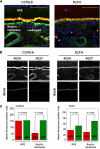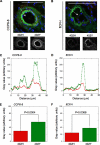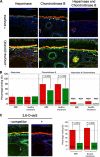Impaired binding of the age-related macular degeneration-associated complement factor H 402H allotype to Bruch's membrane in human retina
- PMID: 20660596
- PMCID: PMC2943316
- DOI: 10.1074/jbc.M110.103986
Impaired binding of the age-related macular degeneration-associated complement factor H 402H allotype to Bruch's membrane in human retina
Abstract
Age-related macular degeneration (AMD) is the predominant cause of blindness in the industrialized world where destruction of the macula, i.e. the central region of the retina, results in loss of vision. AMD is preceded by the formation of deposits in the macula, which accumulate between the Bruch's membrane and the retinal pigment epithelium (RPE). These deposits are associated with complement-mediated inflammation and perturb retinal function. Recent genetic association studies have demonstrated that a common allele (402H) of the complement factor H (CFH) gene is a major risk factor for the development of AMD; CFH suppresses complement activation on host tissues where it is believed to bind via its interaction with polyanionic structures. We have shown previously that this coding change (Y402H; from a tyrosine to histidine residue) alters the binding of the CFH protein to sulfated polysaccharides. Here we demonstrate that the AMD-associated polymorphism profoundly affects CFH binding to sites within human macula. Notably, the AMD-associated 402H variant binds less well to heparan sulfate and dermatan sulfate glycosaminoglycans within Bruch's membrane when compared with the 402Y form; both allotypes exhibit a similar level of binding to the RPE. We propose that the impaired binding of the 402H variant to Bruch's membrane results in an overactivation of the complement pathway leading to local chronic inflammation and thus contributes directly to the development and/or progression of AMD. These studies therefore provide a putative disease mechanism and add weight to the genetic association studies that implicate the 402H allele as an important risk factor in AMD.
Figures





Similar articles
-
Identification of factor H-like protein 1 as the predominant complement regulator in Bruch's membrane: implications for age-related macular degeneration.J Immunol. 2014 Nov 15;193(10):4962-70. doi: 10.4049/jimmunol.1401613. Epub 2014 Oct 10. J Immunol. 2014. PMID: 25305316 Free PMC article.
-
Complement factor H and age-related macular degeneration: the role of glycosaminoglycan recognition in disease pathology.Biochem Soc Trans. 2010 Oct;38(5):1342-8. doi: 10.1042/BST0381342. Biochem Soc Trans. 2010. PMID: 20863311 Review.
-
Age-dependent changes in heparan sulfate in human Bruch's membrane: implications for age-related macular degeneration.Invest Ophthalmol Vis Sci. 2014 Jul 29;55(8):5370-9. doi: 10.1167/iovs.14-14126. Invest Ophthalmol Vis Sci. 2014. PMID: 25074778
-
The role of complement in age-related macular degeneration: heparan sulphate, a ZIP code for complement factor H?J Innate Immun. 2014;6(4):407-16. doi: 10.1159/000356513. Epub 2013 Dec 7. J Innate Immun. 2014. PMID: 24335201 Free PMC article. Review.
-
Heparan sulfate, including that in Bruch's membrane, inhibits the complement alternative pathway: implications for age-related macular degeneration.J Immunol. 2010 Nov 1;185(9):5486-94. doi: 10.4049/jimmunol.0903596. Epub 2010 Sep 27. J Immunol. 2010. PMID: 20876352 Free PMC article.
Cited by
-
The Challenges and Promise of Complement Therapeutics for Ocular Diseases.Front Immunol. 2019 May 15;10:1007. doi: 10.3389/fimmu.2019.01007. eCollection 2019. Front Immunol. 2019. PMID: 31156618 Free PMC article. Review.
-
Identification of factor H-like protein 1 as the predominant complement regulator in Bruch's membrane: implications for age-related macular degeneration.J Immunol. 2014 Nov 15;193(10):4962-70. doi: 10.4049/jimmunol.1401613. Epub 2014 Oct 10. J Immunol. 2014. PMID: 25305316 Free PMC article.
-
Role of Factor H and Related Proteins in Regulating Complement Activation in the Macula, and Relevance to Age-Related Macular Degeneration.J Clin Med. 2015 Jan 1;4(1):18-31. doi: 10.3390/jcm4010018. J Clin Med. 2015. PMID: 25729613 Free PMC article.
-
Bruch's Membrane Compartmentalizes Complement Regulation in the Eye with Implications for Therapeutic Design in Age-Related Macular Degeneration.Front Immunol. 2017 Dec 19;8:1778. doi: 10.3389/fimmu.2017.01778. eCollection 2017. Front Immunol. 2017. PMID: 29312308 Free PMC article.
-
C-reactive protein and pentraxin-3 binding of factor H-like protein 1 differs from complement factor H: implications for retinal inflammation.Sci Rep. 2018 Jan 26;8(1):1643. doi: 10.1038/s41598-017-18395-7. Sci Rep. 2018. PMID: 29374201 Free PMC article.
References
-
- Hageman G. S., Luthert P. J., Victor Chong N. H., Johnson L. V., Anderson D. H., Mullins R. F. (2001) Prog. Retin. Eye Res. 20, 705–732 - PubMed
-
- Day A. J., Willis A. C., Ripoche J., Sim R. B. (1988) Immunogenetics 27, 211–214 - PubMed
-
- Edwards A. O., Ritter R., 3rd, Abel K. J., Manning A., Panhuysen C., Farrer L. A. (2005) Science 308, 421–424 - PubMed
Publication types
MeSH terms
Substances
Grants and funding
LinkOut - more resources
Full Text Sources
Other Literature Sources
Medical
Miscellaneous

